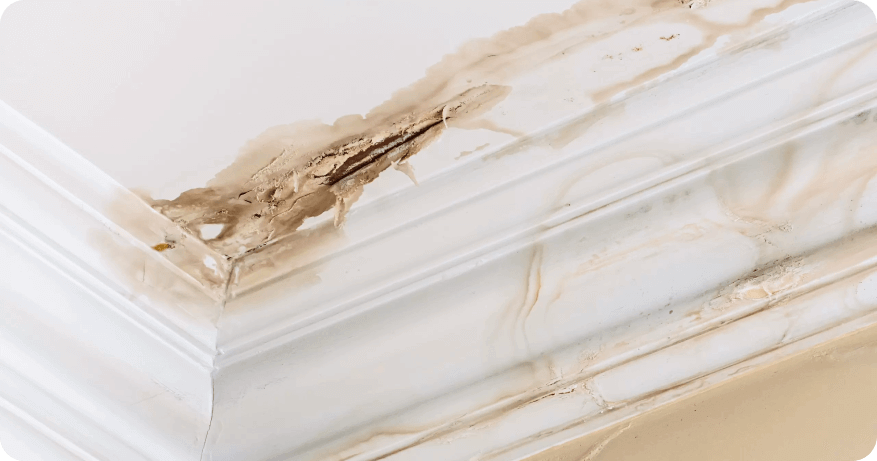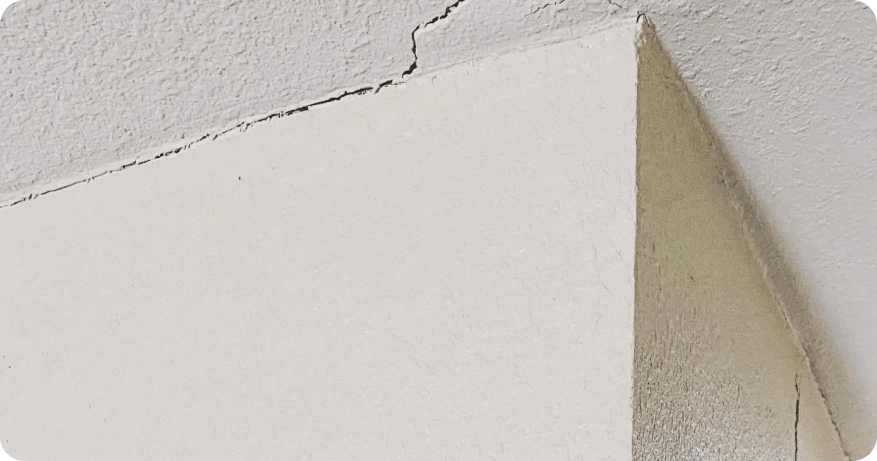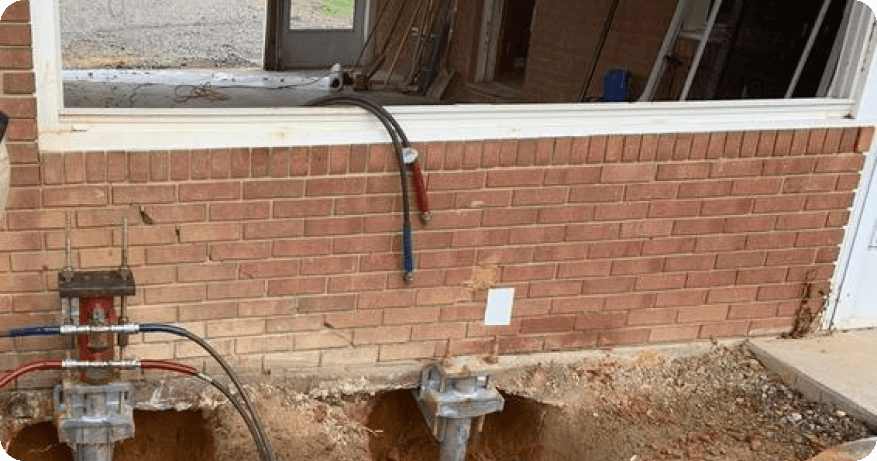Ceiling cracks can be a source of worry for any homeowners in Knoxville, especially when it’s difficult to tell if they’re just a minor cosmetic issue or a sign of a more significant problem. But if you’re concerned about the cracks in your ceiling and want to learn how to gauge their severity, you’ve come to the right place.
So, don’t hit that back button just yet, because in this article, we’ll explore:
- What causes cracks in ceilings?
- Are all ceiling cracks a cause to worry?
- When ceiling cracks a cause to worry?
- Fixing ceiling cracks with professional foundation repair help
By the end of this post, you’ll better understand how to deal with ceiling cracks and ensure the safety of your home.
Don’t let ceiling cracks keep you up at night!
Call Guardian Foundation Repairs for a free quote and protect
your Knoxville home today.
What Causes Cracks in Ceilings?
As mentioned above, ceiling cracks can cause concern for various reasons. In general, they are usually caused by one of two things: structural damage or settling. Understanding the underlying cause of the cracks is important in determining whether or not you need to take action.
Structural Damage
Ceiling cracks caused by structural damage may also indicate foundation problems, which can be a serious issue and needs to be addressed immediately. When a building’s foundation settles or shifts, it can stress the building’s frame, which can cause the ceiling to crack. If left unchecked, this can lead to more severe structural damage.
Natural Settling
Over time, all buildings settle to some degree, which can cause minor cracks in the ceiling. In most cases, these cracks are nothing to worry about, as they are a natural part of the aging process for any structure. However, if the cracks become more severe or grow, it may indicate a larger issue that needs to be addressed.
Moisture Damage
Moisture damage is another common cause of ceiling cracks. If there is a leak in the roof or above the ceiling, water can seep in and cause the ceiling to crack. Additionally, if there is a plumbing leak above the ceiling, this can also lead to moisture damage and ceiling cracks.
Heavy Load on the Floor Above
If there is something heavy on the floor above the ceiling, this can also cause cracks. Bathrooms, for example, can be a common culprit as they often contain heavy items like bathtubs. Likewise, if there isn’t enough ceiling support, this can cause the ceiling to crack.
Poor Workmanship
If the drywall isn’t installed correctly, it can cause ceiling cracks. Poorly taped joints can cause the tape to come loose, leading to cracking. While this type of crack is usually not serious, addressing any issues with the drywall as soon as possible is important.
Are All Ceiling Cracks a Cause to worry?
No! Not all ceiling cracks cause worry; they may sometimes simply be an eyesore. Whether a crack in the ceiling should be a concern depends on various factors, such as location, size, and type. However, it’s worth noting that older homes are more prone to developing cracks due to structural shifts and other significant issues.
Examples of ceiling cracks that are not structurally significant and should not cause concern include:
Spiderweb Cracks
These cracks are often caused by paint build-up after many years and are more common in older homes. They typically have a web-like appearance and do not indicate a serious problem.
Straight Cracks
Most of the time, straight cracks are caused by improper drywall installation. When not enough drywall mud is used, the tape can pull away, creating what looks like a ceiling crack. These cracks may be unsightly, but they are not usually a cause for concern.
It’s important to keep an eye on any cracks, even if they don’t appear to be serious. If a crack starts to get bigger, it could indicate a more significant problem, and it’s essential to contact house foundation repair services right away.
When Ceiling Cracks a Cause to Worry?
There are instances when ceiling cracks can signify a more serious problem. Homeowners should be aware of the warning signs of structural ceiling cracks so that they can immediately contact a foundation repair contractor.
Here are some ceiling cracks that should raise concern as they indicate structural damage:
Ceiling Crack Accompanied by Sagging
When a ceiling crack is accompanied by sagging, this clearly indicates a serious structural problem that requires immediate professional attention.
Ceiling Crack Going Across the Ceiling and Down a Wall
This type of crack indicates that the foundation has shifted or settled, causing the walls and ceiling to pull away from each other.
A Cluster of Small Ceiling Cracks
A cluster of small cracks may seem insignificant but could indicate a more severe problem. Therefore, it’s important to have them inspected by a professional.
Wide Cracks
Any ceiling crack wider than 1/8 inch is considered significant and should be checked by a professional.
Diagonal Cracks
Cracks that run diagonally across the ceiling are usually caused by foundation movement and require professional attention.
Discolored Cracks
Discolored ceiling cracks may indicate water damage, and the source of the water needs to be addressed to prevent further damage.
The Gap Between Wall and Ceiling
Although not technically a ceiling crack, a gap between the wall and the ceiling is a sign of foundation movement.
Signs of Structural Damage to Look for When You Spot Ceiling Cracks:
If you see any of the above-mentioned ceiling cracks, further investigation is crucial to determine if they indicate any underlying structural damage.
Here are some things to watch out for:
- Uneven floors that slope or sag
- Doors and windows that stick
- Cracks in flooring that extend across multiple tiles or in a straight line
- Bowed or cracked walls
- Wall rotation caused by excess moisture under the foundation
- Cracked or out-of-place moldings due to shifting foundation
- Stair-step cracks in bricks or masonry
- Walls that are no longer in contact with the floor or ceiling
- Separation of porches or chimneys from the building
- Water in your basement, which could indicate foundation wall cracks
It’s also important to consider whether recent earthquakes, landslides, or sinkhole problems may have caused structural damage. Keep an eye out for these warning signs, and if you see any of them, it’s essential to contact a foundation repair contractor for an inspection.
Alternatively, you can hire a structural engineer to inspect the foundation and provide a report to the contractor. Keep in mind that structural engineers charge for their services.
Secure your home today with a free inspection and estimate
from Guardian Foundation Repair!
Steps Homeowners Can Take to Prevent Foundation Problem
Preventing foundation problems is crucial for homeowners to maintain the structural integrity of their homes. Poor drainage around the foundation can lead to differential settlement, which can cause foundation problems, including ceiling cracks.
Steps homeowners can take to control groundwater causing foundation issues:
- Slope the yard away from the foundation to prevent water from pooling around it.
- Clean gutters regularly to prevent water from overflowing onto the soil around the foundation.
- Use downspout extensions to channel water away from the foundation to prevent it from sinking into the soil.
- Avoid planting water-hungry flowers and shrubs near the foundation to prevent excess moisture from accumulating around it.
- Keep large trees away from the foundation as they can absorb moisture from the soil and create voids, causing the home to sink.
- Install an effective exterior drainage system and French drain installation to help keep water away from the foundation and prevent the foundation from settling.
Fixing Ceiling Cracks with Professional Foundation Repair Help
For small cosmetic cracks, you can typically repair them by removing the old paint or plaster and applying a fresh coat. However, if the cracks continue to appear and enlarge, it may indicate more serious structural problems like the differential settlement. Differential settlement is when the foundation of a home settles at different rates, causing unevenness and cracks in the walls and ceilings. In such cases, underpinning techniques used by foundation repair specialists may be necessary to extend the foundation depth and stabilize the structure.
At Guardian Foundation Repair, we use push-pin pier systems, a common method for lifting and stabilizing foundations experiencing differential settlement.
This involves installing steel brackets to the foundation and driving steel piers or pipes through them hydraulically into the soil until they reach load-bearing strata or bedrock. Once the piers have reached the stable soil, a synchronized hydraulic lifting system raises the house as needed.
After the lifting process, any cracks caused by the settlement can typically close up, although it depends on the extent of the damage.
Our push-pin pier systems ensure the stability and longevity of your home’s foundation, preventing further settlement and structural damage.
So if you’re seeing cracks in your ceiling or walls, contact Guardian Foundation Repair now for a free inspection and estimate. We’ll provide the best solutions to ensure your home is stable and secure.
Get started today!



